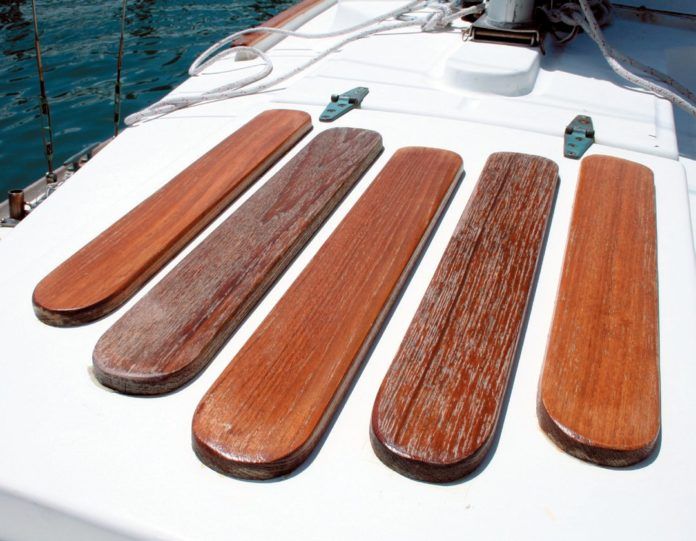I own a 42-foot Pearson 424 with lots of bright work. I’ve absolutely had it with Cetol! There must be something that is easier to use than this. It forms a dark coating after a few years and begins to peel in splotches. Then you have to remove it, clean the teak, and start over. Oh, the stuff goes on clear so if you spill a drop on your gelcoat, you can’t see it until it ambers. Once that happens, you can never get it off. I’m trying Semco Natural. I tried a small area a couple of years ago and so far have had good luck. While it isn’t as durable as Cetol, it doesn’t build-up.
Rich Carter
Pearson 424, via PS Online
Because stripping and removing a coating from your caprail-with all its small corners, and hardware to work around-is so much harder than simply touching it up, the switch to a sealer like Semco can make sense. In the April 2017 PS Advisor we weighed the pros and cons of all of these coatings, and if you are going to use any of them, a sealer requires the least amount of effort exerted in one fell swoop. You’ll also want to review our series of wood finish reports in 2009-2011, covering the most widely sold of the wood finishes for boats (We are currently working on an update, although only a few new products have entered the market.)
Akzo Nobel, the makers of both products, recommends prepping and recoating either product on an annual basis. Prepping usually only requires scuffing with a green 3M Scotch-Brite pad, wiping down with a solvent to remove any dust, oil or grease, and recoating. Yours must have been fairly long gone.
Based on observation, reader surveys, and our own panel tests, 12 months is about as long as you can expect either of these products to maintain their new or shiny appearance without recoating. One caprail coated with the Natural Cetol alone, which was left untouched for the duration of the test, required a complete refinishing after about 18 months of exposure in the tropics. Refinishing in this case (a 30-footer) did not require any scraping or removal with a heat gun, just a long day with a palm sander, sanding blocks, and some 3M Scotch-Britepads.
If Cetol stains the gelcoat, a heavy-duty rubbing compound (see Heavy Duty Rubbing Compounds, PS April 2014 online) is probably your best bet for removing the Cetol, but the answer depends somewhat on your non-skid. If its molded gelcoat and in good condition, you can try to clean it with a Scotch-Brite pad and a cleaner like Interlux 202, or you may have to sand it off.
If its an older molded gelcoat that’s porous, Interlux recommends pouring a solvent like acetone, Xylene, or MEK on the stain, then covering it with plastic to keep the solvent from evaporating; wait 30 minutes or so, then clean the surface with a Scotch-Brite pad. If it is a nonskid paint, then sand off the Cetol and retouch with the paint. Some paint removers may also help, but Interlux Interstrip 299E should not be used on deck, according to the maker.
Semco is a popular sealer and a good choice for someone who doesn’t want to deal with a big refinishing project in the future. This is what contributors John and Amanda Neal use on their Hallberg-Rassy. Be careful in assuming that Semco does not stain gelcoat. In our experience, it will stain the gelcoat if it is not wiped away immediately.









































I’ve been using Semco for the last four years, while it is very easy to apply and looks good right after application (two coats, as directed), it doesn’t last more than one sunny season, nor maintaining the sealing function.
So far, my experience with Cetol is way better. Yes, it requires better preparation and the application isn’t as easy, but at the areas used, it holds perfectly well for over a year. A neighboring boat, has it, two coats of Cetol natural teak and two coats Cetol gloss for the last five years and it still look like new.